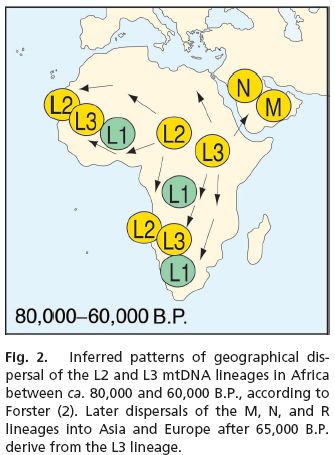A new paper by Paul Mellars in PNAS seems to support the main elements of this thesis. From the paper:

Proc. Natl. Acad. Sci. USA, 10.1073/pnas.0510792103
Why did modern human populations disperse from Africa ca. 60,000 years ago? A new model
Paul Mellars
Recent research has provided increasing support for the origins of anatomically and genetically "modern" human populations in Africa between 150,000 and 200,000 years ago, followed by a major dispersal of these populations to both Asia and Europe sometime after ca. 65,000 before present (B.P.). However, the central question of why it took these populations {approx}100,000 years to disperse from Africa to other regions of the world has never been clearly resolved. It is suggested here that the answer may lie partly in the results of recent DNA studies of present-day African populations, combined with a spate of new archaeological discoveries in Africa. Studies of both the mitochondrial DNA (mtDNA) mismatch patterns in modern African populations and related mtDNA lineage-analysis patterns point to a major demographic expansion centered broadly within the time range from 80,000 to 60,000 B.P., probably deriving from a small geographical region of Africa. Recent archaeological discoveries in southern and eastern Africa suggest that, at approximately the same time, there was a major increase in the complexity of the technological, economic, social, and cognitive behavior of certain African groups, which could have led to a major demographic expansion of these groups in competition with other, adjacent groups. It is suggested that this complex of behavioral changes (possibly triggered by the rapid environmental changes around the transition from oxygen isotope stage 5 to stage 4) could have led not only to the expansion of the L2 and L3 mitochondrial lineages over the whole of Africa but also to the ensuing dispersal of these modern populations over most regions of Asia, Australasia, and Europe, and their replacement (with or without interbreeding) of the preceding "archaic" populations in these regions.
Link

No comments:
Post a Comment